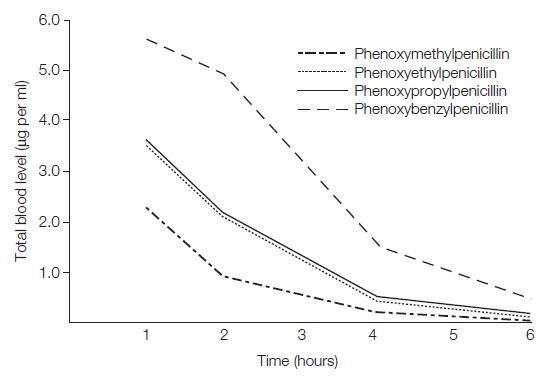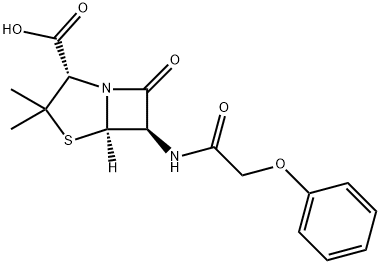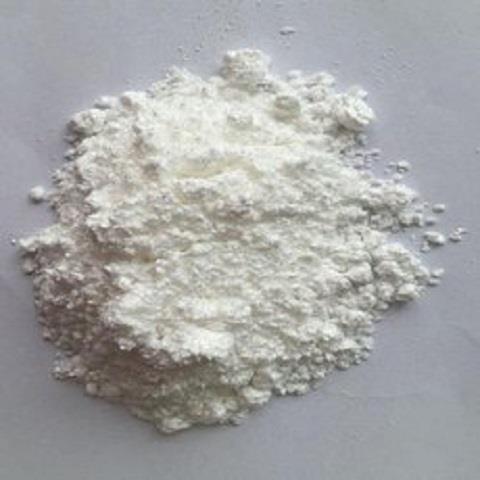Phenoxypenicillins: Antimicrobial Activity, Susceptibility, Administration and Dosage Clinical Uses etc.
Four acid-stable phenoxypenicillins have been developed, all suitable for oral administration. Their clinical use is restricted for the treatment of minor infections and chemoprophylaxis since the serum levels attained are not high.
a. Phenoxymethylpenicillin (penicillin V)
Phenoxymethylpenicillin was introduced in 1953 (Spitzy, 1953) and has been widely used as an ‘‘oral penicillin.’’ Penicillin V (Pen V), like Pen G, is a natural penicillin produced biosynthethically. It is obtained if the precursor, phenoxyacetic acid, is added to the fermentation medium, whereas addition of phenylacetic acid results in production of penicillin G. The chemical structure of Pen V is shown in Figure 2.1.
b. Phenoxyethylpenicillin (phenethicillin)
With the discovery of the penicillin nucleus, 6-APA, it became possible to synthesize new penicillins by the introduction of side chains (Batchelor et al., 1959). Phenoxyethylpenicillin, an oral penicillin analogous to penicillin V, was the first penicillin produced semisynthetically.
c. Phenoxypropylpenicillin and phenoxybenzylpenicillin (propicillin and phenbenicillin)
These semisynthetic penicillins, analogous to penicillin V, were introduced in the early 1960s. Although they are better absorbed from the gastrointestinal tract, overall they are inferior to phenoxymethylpenicillin and phenoxyethylpenicillin because of their lower antibacterial activity (Bond et al., 1963). They are therefore no longer used.
Penicillin V and phenethicillin are very similar, but differ slightly in their antibacterial activity and absorption from the gastrointestinal tract. They are both formulated as potassium salts. Penicillin V is the only phenoxypenicillin commonly available. Table 2.1 summarizes the four phenoxypenicillins.

Figure 2.1 Chemical structure of phenoxymethylpenicillin (penicillin V).
ANTIMICROBIAL ACTIVITY
The antimicrobial spectrum of the phenoxypenicillins is similar to that
of penicillin G (see Chapter 1, Benzylpenicillin (Penicillin G)). Table
2.2 summarizes the activity of Pen V against common pathogens.
These compounds are active against Gram-positive cocci, such
as Streptococcus pyogenes, S. pneumoniae, non-penicillinase (betalactamase)-
producing Staphylococcus aureus, S. viridans, and anaerobic
streptococci. Gram-positive bacilli, such as Clostridium tetani, C. perfringens, and C. diphtheriae, are also susceptible, although occasional
resistance in Bacillus anthracis has been described (Garrod, 1960a;
Barber and Waterworth, 1962; see Chapter 1, Benzylpenicillin
(Penicillin G)).
Among Gram-negative bacteria, most Neisseria meningitidis and Pen
G-sensitive N. gonorrhoeae.
There are some differences in the activity of penicillin G and these compounds, and also some slight differences between the two phenoxypenicillins. Their activity against streptococci, pneumococci, and non-beta-lactamase-producing staphylococci decreases in the order penicillin G, penicillin V, and phenethicillin. Penicillin G is about four times more active than penicillin V against meningococci and gonococci, and phenethicillin is even less active than penicillin V (Garrod, 1960a; Garrod, 1960b). The activity of penicillin G against H. influenzae is between four and eight times greater than that of penicillin V or phenethicillin.
MODE OF DRUG ADMINISTRATION AND DOSAGE
a. Adults
Pen V is available as 125-, 250- and 500-mg capsules or tablets, and as a pediatric syrup, 125 or 250 mg in 5 ml. These drugs are administered orally, with the usual dose for adults of 250–500 mg administered 6- hourly. These drugs should be given when fasting, preferably about 1 hour before meals. Higher doses may be used for the treatment of more serious infections.
Several studies have shown that oral penicillin V is effective in streptococcal pharyngitis and bacterial upper respiratory tract infections if the total daily dose is administered in two divided doses instead of three or four divided doses (Gerber and Markowitz, 1985; Fyllingen et al., 1991a; Fyllingen et al., 1991b). Persistence of carriage is a definite concern after penicillin treatment. There is speculation that this can be due to tolerance or co-pathogenicity due to b-lactamase production by the commensal upper respiratory tract flora. More b-lactamase-stable agents, such as cephalosporins, probably offer an advantage if eradication is considered important.
b. Newborn infants and children
The pediatric syrup contains 125 or 250 mg in 5 ml. The Pen V dosage for children under five years is 125 mg four times a day, and for children over five years is the same as for adults, 250–500 mg 6-hourly. In one study in children, 250 mg of Pen V given twice daily was found to be equally as effective as 250 mg given three times daily for the treatment of streptococcal pharyngitis (Gerber et al., 1985). 4c. Altered dosages Dosage adjustments are rarely needed, unless substantial renal impairment is noted.
PHARMACOKINETICS AND PHARMACODYNAMICS
a. Bioavailability
After oral administration of these compounds, peak serum levels are obtained within 30 minutes to 1 hour (see Fig. 2.2). There is considerable variation in the absorption of oral phenoxypenicillins, and some patients, for reasons unexplained, absorb them poorly. Peak serum levels may be three times higher, and the total amount of a phenoxypenicillin absorbed about doubled, if the dose is taken 1 hour before meals rather than with food (Bell, 1970; Welling and Tse, 1982). This also applies to the absorption of Pen V suspension in children (McCracken et al., 1978). Diarrhea of short duration does not influence the absorption of oral penicillins, but, if diarrhea persists for a week,absorption is usually reduced (Bolme and Eriksson, 1975). Similarly, oral penicillin absorption is reduced in patients with celiac disease and other malabsorption states (Prescott, 1974; Bolme and Eriksson, 1978).

b.Drug distribution
Phenoxypenicillins, like penicillin G, diffuse readily into pleural, pericardial, ascitic, and synovial fluids and pass into the fetal circulation. There is very little penetration of the phenoxypenicillins into the CSF if the meninges are uninflamed. Penicillin V penetrates poorly into maxillary sinus secretions (Lundberg and Malmborg, 1973). In inflamed tonsillar tissue, the concentration is about 20% of the serum level at that time (Roos et al., 1986).
c. Clinically important pharmacokinetic and pharmacodynamic features
Few studies have been undertaken with Pen V, but it can be assumed that, similar to other beta-lactams, clinical efficacy of Pen G is best correlated with the duration of the dosing period in which the drug levels at the site of infection are above the MIC of the infecting pathogen.
d. Excretion
About 20–40% of a given dose can be recovered from urine during the first 6 hours. The drugs are mainly excreted unchanged, but small amounts of antibacterially active breakdown products are also present in the urine (Bond et al., 1963). Renal tubular secretion of the phenoxypenicillins can be partially blocked by probenecid. Only small amounts are excreted in the bile, mainly in the unchanged form.
TOXICITY
a. Gastrointestinal side-effects
Transient disturbances, such as nausea and diarrhea, can follow administration of these drugs. Candidiasis may also occur. Pseudomembranous colitis developed in one 12-year-old girl following a 4-day course of oral phenoxymethylpenicillin (Larson et al., 1977; Barrison and Kane, 1978).
b. Hypersensitivity reactions
These may occur in penicillin-sensitive patients. Phenoxypenicillins
may be cross-allergenic with penicillin G and also with all other
penicillins (see Chapter 1, Benzylpenicillin (Penicillin G)) and include
both anaphylaxis and serum sickness.
Anaphylaxis is much less common with the oral phenoxypenicillins
than with parenteral Pen G. In one patient, symptoms started 30
minutes after ingestion of 500 mg of penicillin V (Coates, 1963). In another patient, generalized pruritus and flushing commenced within 3
minutes of ingestion of a tablet of penicillin V. This was followed by
abdominal cramps, nausea, and vomiting; she received medical
treatment 30 minutes after the dose when she was semiconscious,
cyanosed with tachycardia and hypotension. She responded to
standard resuscitative measures (Simmonds et al., 1978). Serum
sickness reactions are similar to those which occur after penicillin G.
c. Direct toxicity
Oral penicillins are of low toxicity, but massive doses, like those used with penicillin G (see Chapter 1, Benzylpenicillin (Penicillin G)), have not been administered to humans. Penicillin V is well tolerated in doses of up to 6 g/day.
d. Hemolytic anemia
One case of hemolytic anemia has been reported in a three-year-old boy who was treated with penicillin V in a dose of 125 mg 6-hourly (Bird et al., 1975). This was an immune hemolytic anemia due to a penicillin antibody of the IgM class. Antibodies of the IgM class may also be implicated in hemolytic anemias following penicillin G administration in ordinary doses, but more commonly hemolytic anemia induced by penicillin G is a sequel to large doses and antibody of the IgG class is involved.
e. Jaundice
Beeley et al. (1976) reported one adult patient who developed liver damage as part of a severe hypersensitivity reaction to penicillin V.
f. Cation toxicity
The phenoxypenicillins are marketed as potassium salts. Doses so far employed (up to 8 g/day) would not cause potassium intoxication, unless there is serious renal insufficiency.
CLINICAL USES OF THE DRUG
Phenoxypenicillins are suitable for the oral treatment of mild or convalescent infections due to S. pyogenes, such as pharyngitis, scarlet fever, and cellulitis. Mild or moderate acute streptococcal pharyngitis in children can usually be successfully treated by one of these drugs, provided that parents are instructed on the importance of regular medication (Colcher and Bass, 1972). Despite some previous doubts, it has been demonstrated that penicillin V therapy has a beneficial impact on the clinical course of S. pyogenes pharyngitis (Randolph et al., 1985), although the clinical significance of a day or two of fewer symptoms is questionable given current issues of bacterial resistance. A large population-based study in the UK indicated that approximately 4000 patients with upper respiratory tract infection (URTI) needed to be treated with antibiotics to prevent one significant complication, such as quinsy or meningitis (Petersen et al., 2007).
Rheumatic fever chemoprophylaxis
Long-term administration of penicillin V is recommended for patients who have had prior rheumatic fever to prevent recurrence of the disease (Leading article, 1982). Intramuscular injections of 1.2 million units (0.9 g) of benzathine penicillin G can also be used for this purpose (see Chapter 1, Benzylpenicillin (Penicillin G)), but it now seems that these injections should be given once every 2 weeks. If compliance can be assured, oral chemotherapy is often preferred, in which case penicillin Vor amoxicillin is recommended (Garrod, 1975).
Streptococcus pneumomiae infections
Phenoxypenicillins are suitable for the treatment of mild or convalescent pneumococcal infections, such as pneumonia, sinusitis, and otitis media. In young children, otitis media can be caused by H. influenzae, and in these cases the results of treatment with oral phenoxypenicillins are poor, as serum levels attained following the usual doses are rarely high enough to inhibit this pathogen (Kamme and Lundgren, 1971; Laurin et al., 1985). It has been shown that amoxicillin–clavulanate is superior to penicillin V in the treatment of acute otitis media (Thomsen et al., 1997). Three meta-analyses have shown that penicillin V is as efficacious as broader-spectrum agents in bacterial sinusitis (Lindbaek, 2004).
References
Barber M, Waterworth PM (1962). Antibacterial activity of the penicillins.
Br Med J 1: 1159.
Barrison IG, Kane SP (1978). Penicillin-associated colitis. Lancet 2: 843.
Batchelor FR, Doyle FP, Nayler JHC, Rolinson GN (1959). Synthesis of penicillin:
6-aminopenicillanic acid in penicillin fermentation. Nature 183: 257.
Beeley L, Gourevitch A, Kendall MJ (1976). Jaundice after oral penicillin.
Lancet 2: 1297.
Bell SM (1970). Supervision of antibiotic treatment – an important medical
responsibility. Aspects of Infection, p. 107. Auckland, Sydney and Melbourne:
Symposium Proceedings.
Berrios X, del Campo E, Guzman B, Bisno AL (1993). Discontinuing rheumatic
fever prophylaxis in selected adolescents and young adults. Ann Intern Med
118: 401.
Bird GWG, McEvoy MW,Wingham J (1975). Acute haemolytic anaemia due to
IgM penicillin antibody in a 3-year-old child: a sequel to oral penicillin. J Clin
Path 28: 321.
Bolme P, Eriksson M (1975). Influence of diarrhoea on the oral absorption of
penicillin V and ampicillin in children. Scand J Infect Dis 7: 141.
Bolme P, Eriksson M (1978). Absorption of phenoxymethylpenicillin in children.
The influence of age, state of disease and pharmaceutical preparation. Scand
J Infect Dis 10: 223.
Bond JM, Lightbown JW, Barber M, Waterworth PM (1963). A comparison of
four phenoxypenicillins. Br Med J 2: 956.
Buchanan GR, Siegel JD, Smith SJ, De Passe BM (1982). Oral penicillin
prophylaxis in children with impaired splenic function: a study of
compliance. Pediatrics 70: 926.
Busch DF, Kureschi LA, Sutter VL, Finegold SM (1976). Susceptibility of
respiratory tract anaerobes to orally administered penicillins and
cephalosporins. Antimicrob Agents Chemother 10: 713.


